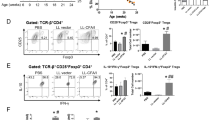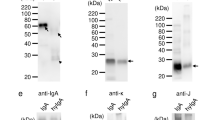Abstract
Oral administration of protein can induce antigen-specific immune hyporesponsiveness1. However, the utility of oral tolerance to autoantigens in the treatment of autoimmune diseases may be limited when candidate autoantigens cannot be produced by conventional systems in quantities sufficient for clinical studies. Plants may be ideally suited for this purpose, as they can synthesize, glycosylate and assemble mammalian proteins to provide huge quantities of relatively low cost soluble proteins2. Furthermore, edible transgenic plants could provide a simple and direct method of autoantigen delivery for oral tolerance. Therefore, the aim of this study was to determine whether a transgenic plant expression system was capable of synthesizing the diabetes-associated autoantigen, glutamic acid decar-boxylase (GAD)3,4 in an immunogenic form and whether the oral administration of an autoantigen expressed by a plant could directly induce protective immune responses in a mouse model of diabetes. We show that a GAD-expressing transgenic plant, given as a dietary supplement, inhibits the development of diabetes in the non-obese diabetic (NOD) mouse.
This is a preview of subscription content, access via your institution
Access options
Subscribe to this journal
Receive 12 print issues and online access
$209.00 per year
only $17.42 per issue
Buy this article
- Purchase on Springer Link
- Instant access to full article PDF
Prices may be subject to local taxes which are calculated during checkout
Similar content being viewed by others
References
Weiner, H.L. et al. Oral tolerance: Immunologic mechanisms and treatment of animal and human organ-specific autoimmune diseases by oral administration of autoantigens. Annu. Rev. Immunol. 12, 809–837 (1994).
Sijmons, P.C. et al. Production of correctly processed human serum albumin in transgenic plants. BioTechnology 8, 217–221 (1990).
Tisch, R. et al. Immune response to glutamic acid decarboxylase correlates with insulitis in non-obese diabetic mice. Nature 366, 72–75 (1993).
Kaufman, D.L. et al. Spontaneous loss of T-cell tolerance to glutamic acid decarboxylase in murine insulin-dependent diabetes. Nature 366, 69–72 (1993).
De Aizpura, H.J., Wilson, Y.M. & Harrison, L.C. Glutamic acid decarboxylase autoantibodies in preclinical insulin-dependent diabetes. Proc. Natl. Acad. Sci. USA 89, 9841–9845 (1992).
Makino, S. et al. Breeding of non-obese diabetic strain of mice. Exp. Anim. 29, 1–13 (1980).
Elliott, J.F. et al. Immunization with the larger isoform of mouse glutamic acid decarboxylase (GAD67) prevents autoimmune diabetes in NOD mice. Diabetes 43, 1494–1499 (1994).
Tian, J. et al. Nasal administration of glutamate decarboxylase (GAD65) peptides induces Th2 responses and prevents murine insulin-dependent diabetes. J. Exp. Med. 183, 1561–1567 (1996).
Tian, J. et al. Modulating autoimmune response to GAD inhibits disease progression and prolongs graft survival in diabetes-prone mice. Nature Med. 2, 1348–1353 (1996).
Kaufman, D.L., McGinnis, J.F., Krieger, N.R. & Tobin, A.J. Brain glutamate decarboxylase cloned in lambda gt-11: Fusion protein produces gamma-aminobutyric acid. Science 232, 1138–1140 (1986).
Katarova, Z., Szabo, G., Mugnaini, E. & Greenspan, R.J. Molecular characterization of the 62 kD form of glutamic acid decarbonxylase from the mouse. Eur. J. Neurosci. 2, 190–202 (1990).
Karlsen, A.E. et al. Cloning and primary structure of a human islet isoform of glutamic acid decarboxylase form chromosome 10. Proc. Natl. Acad. Sci. USA 88, 8337–8341 (1991).
Friedman, A. & Weiner, H.L. Induction of anergy or active suppression following oral tolerance is determined by antigen dosage. Proc. Natl. Acad. Sci. USA 91, 6688–6692 (1994).
Chen, Y. et al. Peripheral deletion of antigen-reactive T cells in oral tolerance. Nature 376, 177–180 (1995).
Zhang, Z.J., Davidson, L., Eisenbarth, G. & Weiner, H.L. Suppression of diabetes in nonobese diabetic mice by oral administration of porcine insulin. Proc. Natl. Acad. Sci. USA 88, 10252–10256 (1991).
Qin, H.-Y. et al. GAD specific T cell tolerance and TH1 to TH2 switch in mouse GAD67 or adjuvant immunized NOD mice. Autoimmunity 21, 50 (1995).
Haq, T.A., Mason, H.S., Clements, J.D. & Arntzen, C.J. Oral immunization with a recombinant bacterial antigen produced in transgenic plants. Science 268, 714–716 (1995).
Genain, C.P. et al. Late complications of immune deviation therapy in a non-human primate. Science 274, 2054–2057 (1996).
Blanas, E., Carbone, F.R., Allison, J., Miller, J.F.A.P. & Health, W.R. Induction of autoimmune diabetes by oral administration of autoantigen. Science 274, 1707–1709 (1990).
Carrington, J.C. & Freed, D.D. Cap-independent enhancement of translation by a plant potyvirus 5′ nontranslated region. J. Virol. 64, 1590–1597 (1990).
Ditta, G., Stanfield, S., Corbin, D. & Helinski, D.R. Broad host range DNA cloning system for gram-negative bacteria: construction of a gene bank of Rhizobium meliloti. Proc. Natl. Acad. Sci. USA 77, 7347–7351 (1980).
Horsch, R.B. et al. A simple and general method for transferring genes into plants. Science 227, 1229–1231 (1985).
De Block, M. Genotype-independent leaf disc transformation of potato (Solanum tuberosum) using Agrobacterium Tumefaciens. Theor. Appl. Genet. 76, 767–774 (1988).
Laemmli, U.K. Cleavage of structural proteins during the assembly of the head of bacteriophage T4. Nature 227, 680–685 (1970).
Author information
Authors and Affiliations
Rights and permissions
About this article
Cite this article
Ma, SW., Zhao, DL., Yin, ZQ. et al. Transgenic plants expressing autoantigens fed to mice to induce oral immune tolerance. Nat Med 3, 793–796 (1997). https://doi.org/10.1038/nm0797-793
Received:
Accepted:
Issue Date:
DOI: https://doi.org/10.1038/nm0797-793
This article is cited by
-
Current advances and future prospects in production of recombinant insulin and other proteins to treat diabetes mellitus
Biotechnology Letters (2022)
-
Plant-based vaccines for oral delivery of type 1 diabetes-related autoantigens: Evaluating oral tolerance mechanisms and disease prevention in NOD mice
Scientific Reports (2017)
-
Glycoengineering in plants for the development of N-glycan structures compatible with biopharmaceuticals
Plant Biotechnology Reports (2014)
-
Construction of a Der p2-transgenic plant for the alleviation of airway inflammation
Cellular & Molecular Immunology (2011)



